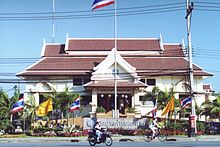Thesaban
Thesaban ( Thai : เทศบาล , RTGS transcription Thetsaban , pronounced: [ tʰêːtsàbaːn ]) are the city councils in Thailand . A distinction is made - depending on the number of inhabitants and other criteria - between big city, city and small town. Both Bangkok and Pattaya have special administrative status outside the thesaban system.
The city administrations assume part of the responsibility that is otherwise assigned to the districts ( Amphoe ) or municipalities ( Tambon ) for non-urban or rural areas.
history
The "Thesaban System" was introduced in 1934 by the "Thesaban Organization Act" (Thai: พระราชบัญญัติ จัด ระเบียบ เทศบาล พุ ท ศักราช ๒๔๗๖ ). Since then it has been improved several times, for example by the "Thesaban Act" of 1939 (Thai: พระราชบัญญัติ เทศบาล พุทธศักราช ๒๔๘๑ ), which in turn was replaced by the "Thesaban Act" of 1953. The last change happened in 2003 through the "Thesaban Act (No. 12)".
Big city
Thesaban Nakhon ( Thai : เทศบาล นคร ) is mostly translated as big city . In order to obtain Thesaban Nakhon status, a city must have at least 50,000 inhabitants with a reasonable income to carry out the necessary tasks of a large city.
In the first version of the "Thesaban Act" of 1934, the conditions were: a population of at least 30,000 and a population density of 1,000 per km². In 1939 the population density was set at 2000 / km² and an additional financial cushion. In 1953 the population density was increased again to 3000 per km² before this condition was removed in 2000.
There are currently 30 cities in Thailand with the status Thesaban Nakhon. The major cities of Bangkok and Pattaya each have special administrative status.
- Northern Thailand : Chiang Mai (เทศบาล นคร เชียงใหม่ ), Lampang (เทศบาล นคร ลำปาง ), Chiang Rai (เทศบาล นคร เชียงราย ), Phitsanulok (เทศบาล นคร พิษณุโลก ), Nakhon Sawan (เทศบาล นคร นครสวรรค์ ) and Mae Sot (เทศบาล นคร แม่สอด )
- Northeast Thailand : Nakhon Ratchasima (เทศบาล นคร นครราชสีมา ), Khon Kaen (เทศบาล นคร ขอนแก่น ), Udon Thani (เทศบาล นคร อุดรธานี ), Ubon Ratchathani (เทศบาล นคร อุบลราชธานี ) and Sakon Nakhon (เทศบาล นคร สกลนคร )
- Central and Eastern Thailand : Nonthaburi (เทศบาล นคร นนทบุรี ), Pak Kret (เทศบาล นคร ปากเกร็ด ), Ayutthaya (เทศบาล นคร พระนครศรีอยุธยา ), Nakhon Pathom (เทศบาล นคร นครปฐม ), Rayong (เทศบาล นคร ระยอง ), Samut Prakan (เทศบาล นคร สมุทรปราการ ), Om Noi (เทศบาล นคร อ้อม น้อย ), Samut Sakhon (เทศบาลนคร สมุทรสาคร ), Chao Phraya Surasak (เทศบาลนคร เจ้าพระยา สุรศักดิ์ ), Laem Chabang (เทศบาล นคร แหลม ฉบัง ) and Rangsit (เทศบาล นคร รังสิต )
- Southern Thailand : Surat Thani (เทศบาล นคร สุราษฎร์ธานี ), Hat Yai (เทศบาล นคร หาดใหญ่ ), Songkhla (เทศบาล นคร สงขลา ), Nakhon Si Thammarat (เทศบาลนคร นครศรีธรรมราช ), Trang (เทศบาลนคร ตรัง ), Yala (เทศบาล นคร ยะลา ) and Phuket (เทศบาล นคร ภูเก็ต ) and Ko Samui (เทศบาล นคร เกาะสมุย )
city
Thesaban Mueang ( Thai : เทศบาล เมือง ) is mostly translated as city . To obtain Thesaban Mueang status, a city must either be a provincial capital or have at least 10,000 inhabitants. In addition, a sufficient income must be proven to meet the requirements of a city.
In the first version of the “Thesaban Act” of 1934, the requirements for Thesaban Mueang status were a population of 3000 with a population density of 1000 per km². In 1939 the requirements were increased to a population of 5000 with a population density of 2000 per km². In addition, a sufficient income had to be proven. In 1953, the lower limit for population density was increased again, to 3000 per km². Since 2000 this condition is no longer applicable. The limit for the number of inhabitants was raised in 1953 to the current value.
Town
Thesaban Tambon ( Thai : เทศบาล ตำบล ) is the lowest level of the city administration. Although the name tambon is included, it can either contain only parts of a tambon , but it can also extend over several tambon, but it can also include exactly one tambon.
In order to obtain thesaban tambon status, the community must have a gross income of at least five million baht , must have at least 5000 residents with a population density of 500 residents per km², and it must receive the consent of the residents.
Most of the small towns were originally "sanitary districts" (Sukhaphiban - สุขาภิบาล ). In May 1999, these were all raised to Thesaban Tambon, regardless of whether they met the above conditions or not.
Individual evidence
- ↑ a b c The Royal Gazette, พระราชบัญญัติ จัด ระเบียบ เทศบาล พุ ท ศักราช ๒๔๗๖ , Vol. 51, Page 82-107. April 24, 1934. Last accessed December 3, 2008.
- ↑ a b c The Royal Gazette, พระราชบัญญัติ เทศบาล พุทธศักราช ๒๔๘๑ , Vol. 56, Pages 155-86. April 1, 1939. Last accessed on December 3, 2008.
- ↑ a b c The Royal Gazette, พระราชบัญญัติ เทศบาล พุทธศักราช ๒๔๙๖ , Vol. 70 No. 14, pages 222-257. February 17, 1953. Last accessed December 3, 2008.
- ↑ The Royal Gazette, พระราชบัญญัติ เทศบาล (ฉบับ ที่ ๑๒) พ.ศ. ๒๕๔๖ , Vol. 120 No. 124 ก , Pages 1-15. December 22, 2003. Last accessed December 3, 2008.
- ↑ a b The Royal Gazette, พระราชบัญญัติ เทศบาล (ฉบับ ที่ ๑๑) พ.ศ. ๒๕๔๓ , Vol. 117 No. 41 ก , Pages 12-27. November 12, 2000. Last accessed December 3, 2008.
- ↑ Netherlands Geographical Studies 374 (2008): Institutions and regional development in Southeast Asia, p. 125 ( Memento of the original of March 26, 2009 in the Internet Archive ) Info: The archive link was automatically inserted and not yet checked. Please check the original and archive link according to the instructions and then remove this notice.
See also
- Administrative division of Thailand
- List of cities in Thailand by population
- List of provinces of Thailand
Web links
- History of Administrative Reform (in English)
- http://www.tessaban.com (only in Thai)

